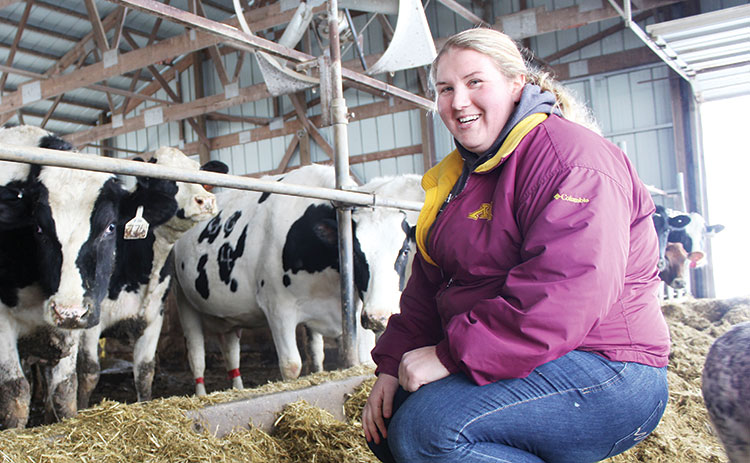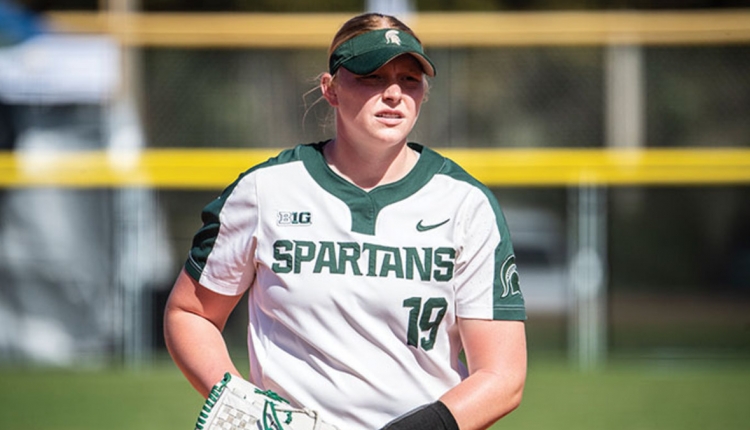
The name Schoene Kuh Dairy is more than just a breeder prefix for young farmer Staci Sexton. Meaning “beautiful cow” in German, Sexton paid tribute to her family’s history while writing her own in Millville, Minn.
“Most of our heritage is German,” Sexton said. “My dad is a little Irish. That is where my parents got the name of their farm, Irish Ridge, because of all of the Irish settlers who came to the area.”
Irish Ridge was established in 1858 before Minnesota became a state. Since 2013, Sexton has been building her own herd on the farm where they milk about 125 cows, 51 of which belong to Sexton. She helps her parents, Vince and Sheri, with breeding and herdsman jobs. The cows run together, but they keep as much separate as possible with individual bulk tanks and separate genetics programs.
A love for the farm
Sexton grew up a typical farm kid being involved in 4-H and FFA, promoting milk as a dairy princess, and showing cattle whenever she could. She enrolled at the University of Minnesota in 2006 and pursued a degree in engineering with a minor in animal science. She was involved in Gopher Dairy Club, agricultural sorority Beta of Clovia, the dairy judging team, and other organizations. Eventually, her passion for farming shone through, and she changed her major to animal science with a dairy production emphasis.
She graduated in 2010 and worked for Land O’Lakes as a dairy production specialist until there was an opportunity to come back to the farm. In addition to working on Irish Ridge Dairy, she custom raised calves for a farmer whom she met while working for Land O’Lakes.
“He did a lot with genetics and genomic testing,” Sexton said. “I was young and ambitious, and the genetics caught my eye.”
Since the farmer no longer milked, she bought his fresh heifers to start Schoene Kuh Dairy in 2013. She wanted to break into genomics for both the Jersey and Holstein breeds. In college, she had purchased two Jersey heifers with a friend. Creating more connections in the industry, she later bought embryos with help from a trusted member of the Jersey Cattle Association.
“I got three out of five pregnancies, which was great, but all bull calves,” Sexton said. “Luckily, Semex bought two of them, so I went back and bought nine more embryos.”
Of the nine embryos, she got seven pregnancies with two heifer calves. None of the bulls were genetically high enough to sell to A.I. studs, but her heifers had quality numbers. Sexton got contracts and started a flushing program.
Today, her herd is 75 percent Holstein and 25 percent Jersey with an Ayrshire and Milking Shorthorn thrown in for fun. While she enjoys all the breeds, Sexton said Jerseys made it easier to make her name in genomics. She said Holsteins can be hard to crack into because of their popularity and the big money invested in the industry.
“You can easily spend $1,000 on a Holstein embryo, and you only get a 50 percent pregnancy rate,” Sexton said. “With Jerseys, I can buy embryos for half the price. There is less of a fertility rate expected on them, but I took a risk and it worked out.”
With Jerseys, Sexton also found more opportunities to successfully work with older cows that are not always the top indexing animals to produce valuable offspring. For example, the Jersey embryos she purchased were from an older, proven cow that produced some of the highest numbered offspring at Schoene Kuh Dairy.
Offsetting costs
The breeds work together to give Sexton a 24,622-pound herd average with 1,003 pounds of fat and 802 pounds of protein. The Holsteins average 27,189 pounds with a 4.2 fat and 3.3 protein. Jerseys sit at a 19,569-pound average with 5.5 fat and 3.9 protein. With the low milk price, Sexton breeds for components and keeps somatic cell counts down to maximize premiums. At last check, her SCC was 79,000.
As their facilities fill, Sexton would like to sell cattle, but low prices discourage her from putting livestock on the trailer. In 2017, they did find a market in Canada for 30 fresh heifers. Sexton sells genetics when she can, but she does not sell many embryos, preferring to keep those for her own herd. Getting bulls into A.I. helped cover the cost of flushing and could help the Schoene Kuh prefix carry more value in sales.
“A lot of people are going to sales looking for high-quality animals,” Sexton said. “I do have some people who contact me after seeing my ad and ask if I have any bulls or heifers around. Hopefully, I will see that more as I develop my herd.”
Grateful for support from her parents, Sexton acknowledged the heavy investment needed to start farming. She recognized FSA (Farm Service Agency) loans can help other young farmers get their start. Personally, Sexton received a Minnesota Livestock Investment Grant three times. The grant paid 10 percent of building costs as she updated the farm’s facilities and built new housing for heifers and calves.
“That helped quite a bit,” Sexton said. “In the new buildings, the cattle use less bedding. They are healthier. They eat better. I’m not spending so much on bedding or extra feed to keep animals warm.”
Her advice
Sexton said young farmers looking to enter the industry need to find their niche and set goals. Understanding that genomics brought her success, she noted that high-type and commercial herds both still have a place in dairy.
“Keep in mind what you want in a herd,” Sexton said. “Once you know what you want, make new goals and set a new plan. We just really need to find the most efficient cows. You don’t have to play the genomics game.”
Looking back at her start, Sexton said she didn’t buy the top genomic cattle right away. She sought good sources for cows to fill her barn, and some of those have lasted three to five lactations. Still learning as she goes, Sexton is never afraid to reach out to people who work among the various breeds to learn from their experiences.
“Genomics is something that I didn’t grow up with,” Sexton said. “It is fun to learn and meet new people through that.”
Sexton already reached some of her goals as a young farmer. She has sent multiple bulls into A.I. and is constantly pushing herself to improve as she evaluates her breeding strategy.
“I hope one day there will be people talking about how they love one of my bulls and are excited to use him in their herd,” Sexton said. “I would like to breed one of the greats.”
Sexton works toward that goal every day, developing and flushing heifers. Ultimately, her ambition is to enjoy life in agriculture as she builds the future of Schoene Kuh Dairy and raises beautiful cows in southeast Minnesota for many years to come.
“I want this farm to have another century in our family.”
Getting started in dairy article series:
- February 25: There’s room for young people in dairy
- March 10: Building her brand
- March 25: Starting a dairy takes a community
- April 10: When friends become farmers










